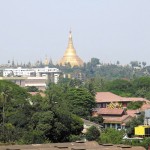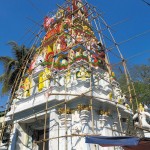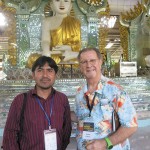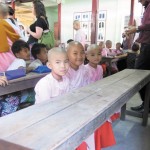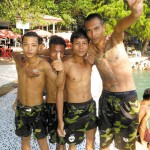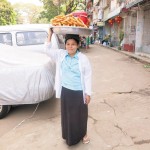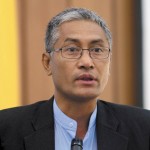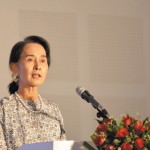Scarred But Hopeful In Myanmar
This is the third in a three-part series.
The long-suffering people of Myanmar see their military rather differently from the way we Americans tend to regard our servicemen and women. After five decades of brutal military dictatorship that ended in 2011, during which the generals became incredibly wealthy while bringing the nation’s economy to its knees, there isn’t much talk in Myanmar about “the courage and sacrifice of our troops” or of “the brave men and women in uniform.”
- Shwedagon Pagoda in Yangon, as seen from the Panda Hotel. Don Chapman photo
- A young man paints figures at a Hindu temple in Yangon. Don Chapman photos
- The author with Pakistani journalist Shakir Ullah at Paya Thon Zu Buddhist temple
When people in Myanmar see a person in uniform, they see a collaborator in violently quashing a peaceful uprising led by Buddhist monks in 2007 – spurred by sudden, dramatic increases in the cost of everything from rice and eggs to gasoline. They see the face of a government that looked the other way, as if it hadn’t happened, when Cyclone Nargis killed at least 138,000 and left 2 million homeless in 2008. And they remember it was the military that shot dead more than 3,000 demonstrators during student-led protests in 1988, jailed many more and caused some to take to the jungle, where it’s said scores died from disease and lack of food and water.
One of those students was Aung Naing Oo. Call him the man who came in from the jungle. Today, he is Myanmar’s associate director of the Peace Dialogue Program, negotiating with ethnic groups – Karen, Mon, Kachin and many others – that have battled the government for generations, seeking greater rights as well as better services, such as electricity and radio on a regular basis, and paved roads.
Aung Naing Oo was a member of the All Burma Federation of Student Unions (ABFSU) that led those protests, known as the 8888 Uprising because it began Aug. 8, 1988.
“I understand the position of the ethnic groups,” he said at the East-West Center-sponsored International Media Conference in Yangon, which drew more than 400 people from 31 countries. “I was one of those who went to the jungle” to avoid being jailed or shot.
- Girls at Paya Thon Zu nunnery and orphanage
- Young men at a Yangon water park
- A woman sells breakfast pastries in Yangon
He is in many ways a symbol of the new Myanmar, scarred but hopeful that – as one conference panelist put it – “the genie of freedom and democracy cannot be put back into the bottle.”
Why the uncertainty about the future? Under the new constitution, the military gets 25 percent of legislative seats – local, state, national – and thus with its allies has blocking power. Changing the constitution to limit the military’s role is the goal of many in parliament during the next 18 months.
(Another former ABFSU leader, Nobel Peace laureate Aung San Suu Kyi, spoke at the conference’s opening luncheon, announcing a new Hawaii-based foundation focused on health and education in Myanmar. You can read about that online in a story by my Star-Advertiser colleague Craig Gima.)
Mr. Oo is just one of the many fascinating people I met at the conference – including two journalists who paid dearly for doing good journalism.
Roxana Saberi, an American whose father is Iranian (and her mother Japanese), was producing TV features from Iran for a variety of news outlets when she was arrested in 2009 and charged with espionage. “They said, ‘You are traveling all over the country asking many questions of many people – you must be a spy,'” she said. She was not allowed an attorney at her trial, and was sentenced to eight years in prison. Fortunately, so to speak, she spent just nine months behind bars before an international outpouring of support prompted the Iranians to release her. She wrote the book Between Two Worlds about that experience, and today the former collegiate soccer player and one-time Miss North Dakota is reporting for Al Jazeerah America.
Then there’s Umar Cheema, a correspondent for The International News of Islamabad, Pakistan. His reporting angered some in the government, and one night in 2010 he was abducted from his home, leaving behind a young son and pregnant wife. “All I could think,” he said, “was I hope to see my family again.” Blindfolded, he was taken to a place where he was stripped, his body shaved (great shame for a Muslim man) and severely beaten. Photos were taken of him, and his abductors vowed they would post the photos online if he were to continue writing such things. So what did Umar do? He went to his newspaper and wrote the story of what had happened to him, and continues to write stories critical of the government. I wondered if I could do that, and hopefully in America will never have to find out.
- Aung Naing Oo
- Aung San Suu Kyi spoke at the International Media Conference. East-West Center photos
Bravery has many faces. I met Steven Gan, editor-in-chief of the “malaysiakini” news website in Kuala Lumpur. About 20 years ago at the height of the generals’ power, he came to Myanmar under the guise of a computer salesman prospecting for business. Instead, through a friend, he arranged to meet Aung San Suu Kyi at the friend’s house. Steven arrived hours early. When Aung San Suu Kyi arrived, she was followed by a motorcade of army vehicles. Over the next few hours he interviewed her and got some photos. When she left, to his dismay, only half the soldiers followed. The rest waited to see who else might exit. Hours later, Steven and a friend made a dash for a car, and a desperate chase ensued. “I knew if they caught me, they’d take my tapes and film, at the least,” Steven said. At last he and his friend abandoned the car and ran: “I was wearing jeans, and at that time I was probably the only guy in the country wearing jeans, so I was easy to spot.” They ducked into a shop and Steven bought a longyi, the cotton skirt favored by Myanmar men, and made his escape.
The old regime was so repressive, by the way (and as reported by Denis Grey in Bangkok Airway’s in-flight magazine), that after the generals built the new capital Nay Pyi Taw in the middle of nowhere (far from the street protests of Yangon) and moved animals from the Yangon Zoo there, a Myanmar comic quipped, “Now all the animals in Myanmar are at Nay Pyi Taw.”
He was promptly jailed.
Umar was one of several Muslim journalists I enjoyed talking with, including two from Iraq. They, Umar and Shakir Ullah, a producer for Radio Pakistan, also were part of a tour of Myanmar religious sites that, in just three hours, allowed me to express my own faith and theology in a rare way, all in the Thingangyun neighborhood of Yangon. By the way, it is said that for every 100 people in Myanmar, 90 are Buddhist, five Christian, three Muslim and two Hindu – though our guide this day, Paula Helfrich (who sends regards to her Honolulu pal Hector Venegas), says the ongoing national census may alter that somewhat – she and others expect a greater percentage of non-Buddhists. Given recent attacks by Buddhists in Rakhine state on the Rohingya Muslim minority, I was especially interested in this opportunity to visit four different faiths in a crowded neighborhood.
First stop was St. Joseph’s Roman Catholic Church – Portuguese priests brought Catholicism to Myanmar in 1514. There I prayed and made the sign of the cross.
Next we visited a Hindu temple, where a young man on bamboo scaffolding was repainting Hindu figures. Inside, after a prayer of thanks to Lord Shiva, I received a red dot on the forehead.
From there it was on to a Paker Mosque, established 153 years ago. It was my first mosque, and only men are allowed in the holy of holies. Following the lead of my new Muslim friends, I washed hands and feet, entered the mosque, prayed, knelt and bowed toward Mecca, again offering thanks. Afterward, they said they “appreciate your kneeling and bowing and praying to Allah.”
“I was trying to follow along with you guys, but probably screwed it all up.”
“No matter,” an Iraqi said. “In the Koran, it says if you pray, Allah will hear.”
Finally, it was on to Paya Thon Zu Buddhist Temple and Monastery, and adjacent nunnery and orphanage. In recent years Buddhist philosophy has become attractive to me, and eminently sensible – in no small part from having covered the Dalai Lama’s last two visits to Hawaii and last year’s trip to interview the head of Shinnyo-en in Japan – and I explained that attraction to my Muslim friends.
“But you were raised Christian?” one of the Iraqis said.
“Yes, I was once in a seminary, and the way I see God now is as the most immense diamond you can imagine, larger than that even, with infinite facets, and if you are lucky one of those facets will reflect light on you and have meaning. I am very lucky because several of God’s facets shine for me. The greatest human conceit is to assume just one religion, much less one sect, expresses the complete and only truth about God.”
“This is how I believe too,” an Iraqi said. “But do you speak to your family of such things?”
“My children, yes, of course. But with other relatives, it doesn’t come up.”
“This is my situation, too – Islam has become too harsh, but I cannot speak of this to my family.”
“But this faith is in your heart.”
“Yes.” “Then you are blessed.” Early the next morning I was checking out of the hotel and ran into one of my Muslim friends.
“Ah, Mr. Don, it was nice to meet you.”
“Thank you, I enjoyed your company very much.”
We bowed, wished each other safe travels and “Go with God.”
It is such interactions, as well as those I’ve written about in the previous two columns, that make me so grateful to have been associated with the East-West Center as a former fellow since 2005. The next International Media Conference, in 2016, is already in my calendar. Can’t wait for the announcement of the site. My suggestion: North Korea.
dchapman@midweek.com

